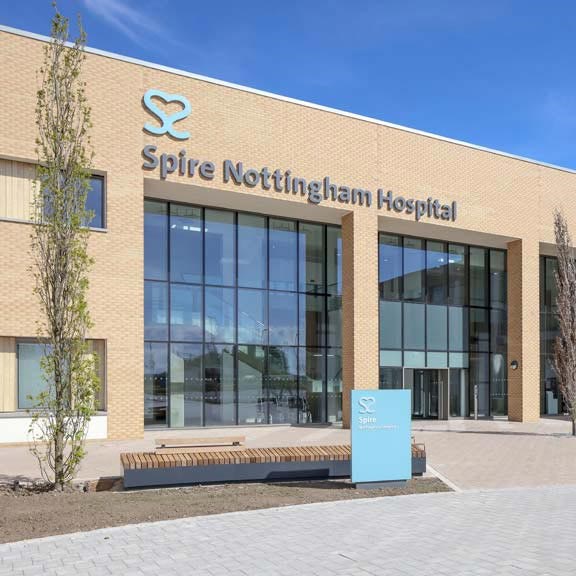Carpal tunnel syndrome surgery
Treatment to relieve pressure and pain in your wrist.
We offer the latest surgical techniques to ease pain and numbness in your hand caused by carpal tunnel syndrome.
Sometimes also called
- Carpal tunnel decompression
- Carpal tunnel release
At a glance
-
Typical hospital stay
Same day discharge -
Procedure duration
20 minutes -
Type of anaesthetic
Local -
Available to self-pay?
Yes -
Covered by health insurance?
Yes
Why Spire?
- 98% of our patients are likely to recommend us to their family and friends
- Clear, inclusive pricing
- Fast access to treatment when you need it
- Internationally and nationally renowned consultants
What is carpal tunnel surgery?
Carpal tunnel surgery is an operation to relieve the symptoms of carpal tunnel syndrome (CTS) by cutting a ligament in your wrist. The ligament runs across the top of your wrist bones and creates a narrow channel in your wrist. This channel is called the carpal tunnel and inside it are tendons and the median nerve, which controls some of the movement in your hand.
In CTS, swelling inside the wrist puts pressure on the median nerve. This causes symptoms such as pain or aching in the hand, fingers, and forearm. Other symptoms include pins and needles, a tingling sensation, numbness in the fingers and a weakened grip. By cutting through the ligament, the pressure is released and the symptoms often go away.
There is no single cause for CTS but you’re more at risk of getting it if you:
- Are overweight
- Are pregnant
- Have a job that requires you to repeatedly bend your wrist or grip objects tightly
- Have another condition that can cause water retention eg diabetes or obesity
- Have arthritis
- Have previously fractured or dislocated your wrist
You’re also at greater risk of CTS if your family members have it.
Sometimes CTS gets better on its own after a few months. If it doesn’t, there’s a risk that your median nerve could be permanently damaged.
Your doctor may suggest carpal tunnel surgery, but usually only after you’ve tried other non-surgical treatments.
Non-surgical carpal tunnel treatments
Non-surgical treatments for CTS include:
- Applying cold packs
- Performing yoga and wrist exercises (eg wrist extension, wrist flexion, wrist lift, median nerve glide and hand squeezes) to strengthen your wrist muscles — conversely, exercises that overextend your wrist should be avoided
- Shaking your hand vigorously
- Steroid injections to reduce inflammation — steroid injections can usually only be given two times in a year
- Taking anti-inflammatory painkillers to reduce inflammation
- Wearing wrist splints at night to keep your wrist in a neutral position
Lifestyle changes may also improve your condition, such as taking breaks regularly to rest your hands and avoiding activities that worsen your symptoms.
If you also have arthritis, specifically gout and rheumatoid arthritis, treating these conditions can reduce the swelling and pain caused by your CTS.
If these non-surgical treatments do not work and your CTS symptoms are affecting your daily life or interrupting your sleep, your doctor may then recommend carpal tunnel surgery. This surgery has a high success rate in reducing the painful symptoms of CTS and improving quality of life. Your doctor will help you decide if surgery is likely to benefit you.
Find your nearest Spire hospital or clinic
Almost all our hospitals offer private carpal tunnel surgery and have consultants who specialise in this procedure. You may be seen by a plastic, orthopaedic or hand surgeon. Carpal tunnel surgery may also be offered at one of our Spire Healthcare Clinics.

How carpal tunnel surgery works
Carpal tunnel surgery is a quick procedure in which your surgeon opens the carpal tunnel and cuts your transverse carpal ligament. This ligament sits across the front of your wrist and connects the small bones in your wrist, helping to form your carpal tunnel.
Cutting the ligament creates more room in your carpal tunnel and reduces pressure on your median nerve — this is called decompression.
The surgery is usually carried out under local anaesthetic, so you’re awake but can’t feel anything in your hand.
Carpal tunnel surgery can be done using open or keyhole surgery.
Open carpal tunnel surgery
Open surgery involves making one cut in your wrist so the surgeon can open the carpal tunnel and cut the ligament.
Keyhole (endoscopic) carpal tunnel surgery
Keyhole surgery uses a smaller cut through which a thin, flexible telescope (an endoscope) is inserted to see inside your wrist. Your surgeon cuts your ligament using a special instrument attached to the endoscope.
Your doctor will advise you on which technique is best for you.
What to expect during carpal tunnel surgery
How long does carpal tunnel surgery take?
The procedure will take about 20 minutes once your anaesthetic has taken effect.
Anaesthetic choices
The surgery is usually carried out under local anaesthetic. This means you’ll be awake during the procedure but can’t feel anything in your hand. Your doctor will recommend the best option for you, taking into account your wishes.
Carpal tunnel syndrome surgery procedure
- You will lie on your back with your arm outstretched by your side on an operating board
- A tourniquet will usually be wrapped around the top of your arm and inflated — this will stop the blood flow down your arm during your surgery, which will reduce bleeding
- A local anaesthetic will be injected into your wrist to numb it
- Your surgeon will check that the local anaesthetic is working before they start the surgery — you may still feel some pressure but you shouldn't feel any pain; if you start to feel any pain during your surgery, tell your surgeon so they can give you another local anaesthetic injection
- Your surgeon will make a cut below your palm and cut your transverse carpal ligament to release the pressure on your median nerve
- Once the surgery is complete, your surgeon will stitch together the cut and apply a sterile dressing
Pain after carpal tunnel surgery
As with any surgery, you’re likely to feel discomfort once the anaesthetic wears off. But you’ll be given painkillers to help you manage this in the following days.
Your hospital or clinic stay
You’ll be able to go home on the same day and won’t need to stay with us overnight. You’ll be given your follow-up appointment details before you leave — this will be around two weeks after the surgery.
After your carpal tunnel surgery
It normally takes a couple of hours for the local anaesthetic to fully wear off, after which you should have full sensation in your wrist again. When possible, you should keep your arm elevated and occasionally clench your fingers to help prevent stiffness and swelling. The dressing around your wound should be kept clean and dry, so when bathing you should wrap your wrist in a plastic bag. You can eat and drink as normal after the procedure.
Q & A
Mr Michael Elvey, Consultant Orthopaedic Hand and Wrist Surgeon
Mr Michael Elvey says carpal tunnel decompression (also called carpal tunnel syndrome surgery) is a simple procedure in which the ligaments that trap your nerve are released.
It's a local anaesthetic surgery that takes 10 to 20 minutes and is a day case procedure, which means you'll come in and leave the same day.
Recovering from carpal tunnel surgery
Everyone’s recovery is different. How long it takes to recover from your surgery will depend on your general health and how severe your CTS is.
It's entirely normal to experience the following in the days and weeks after carpal tunnel surgery:
- Pain around the wound and/or pain when using, or putting pressure on your hand — taking over-the-counter painkillers (eg paracetamol, ibuprofen) will help manage your pain; read the patient information leaflet and/or talk to your pharmacist before taking any painkillers
- Stiffness
- Swelling
- Tender, lumpy, pink scarring
- Weakness in your grip
These symptoms should improve over time and most people find the pain caused by their CTS disappears.
Pain after carpal tunnel surgery
Recovery one–two days after surgery
You’ll be able to leave us on the same day as your surgery and can expect to be able to move your fingers in one or two days.
Recovery one-two weeks after surgery
The stitches around your wrist may be dissolvable and disappear in a week or so. If not, your stitches can be removed between three to 14 days after your surgery.
Recovery three–four weeks after surgery
Speak to your surgeon or physiotherapist about returning to work. Depending on your job, you may be able to go back to work gently after around three weeks.
Recovery one–three months after surgery
You can look forward to getting back to everyday activities in a month or so, but it can take up to three months to regain full strength in your hand.
Carpal tunnel surgery aftercare
Before you leave the hospital or clinic, your nursing team will advise you on how to take care of your hand as it heals. You will need to start moving your hand, as advised, as soon as possible after your surgery to reduce swelling and stiffness. Our nursing team will advise you to:
- Keeping your hand dry until your stitches have been removed
- Keeping your hand up when you aren’t using it
- Keep your hand mobile by performing light activities, such as cleaning your teeth or brushing your hair
Hand exercises
Hand exercises are an important part of recovery. However, you should always follow the advice of your surgeon and/or physiotherapist to ensure you don’t overdo it or perform exercises incorrectly and injure your wrist.
Exercises to help strengthen your wrist include:
- Bending your wrist up and down — repeat this 10 times
- Making a fist by bringing your fingers in towards your palm and then straightening them back out — repeat this 10 times
- Putting both of your hands together with your palms touching (in a prayer position) and then extending your elbows outwards — you should feel a gentle stretching of your wrist
- Touching the tip of each of your fingers with your thumb
Returning to work
When you can return to work will depend on your recovery, how you are feeling and what type of work you do. You may be able to return to work after just 12 days. However, most people return to work after around 19 days of recovery post-surgery.
When you return to work, avoid or limit tasks that put a strain on your wrist, such as typing, lifting heavy objects or holding the phone up to take a call.
Driving after carpal tunnel surgery
You won’t be able to drive after your surgery, so you’ll need to arrange transport home.
You should speak to your motor insurance provider about your surgery, checking your policy before driving again. If you’re still on painkillers, it's important that you’re free of the sedative effects they may be having.
Without driving, you should test how comfortable you are in the driving position, particularly focusing on how comfortably you can operate the steering wheel and perform an emergency stop.
Carpal tunnel surgery recovery timeline
Everyone’s recovery is different. However, most people can leave the hospital or clinic on the same day of their surgery. After one to two days, you will likely be able to wiggle your fingers.
Three to 14 days after surgery, your stitches will be removed, unless they are dissolvable, in which case they will disappear in the first week.
Depending on your type of work, you may be able to return two to three weeks after your surgery. You will still need to avoid tasks that put excess strain on your wrist, such as lifting heavy objects and typing.
You should be able to return to most of your usual activities after a month and expect a full recovery after about three months.
Risks and complications of carpal tunnel surgery
Most people have carpal tunnel surgery without complications but all surgery carries some risks. Your doctor will explain them to you before you go ahead with surgery.
Although rare, carpal tunnel surgery complications can include:
- Bowstringing of your tendons — tendons that pop up when they are flexed or extended
- Complex regional pain syndrome — a chronic (long-term) condition where your hand becomes painful, swollen and sensitive to touch
- Discomfort, pain or tenderness around the scar — this can take several months to go away
- Injury to the median nerve or other nerves
- Stiffness and swelling around the wound — elevating your hand should help reduce swelling
- Weakness or numbness in your hand — this usually gets better once you have completely recovered from your surgery, which can take several months
Your CTS may also recur.
At Spire Healthcare hospitals, your safety is our top priority. We have high standards of quality control, equipment and cleanliness and a rigorous system of review and training for our medical teams.
Treatment and recovery timeline
Although everyone’s different, here’s a typical recovery timeline for carpal tunnel surgery:

Day 1
3 months
Same day
You’ll be able to leave the hospital or clinic
1-2 days
Able to wriggle fingers
3-14 days
Stitches removed
14-21 days
Return to work (depending on your job)
1 month
Resume normal activities
3 months
Fully recovered
-
Same day
You’ll be able to leave the hospital or clinic
-
1-2 days
Able to wriggle fingers
-
3-14 days
Stitches removed
-
14-21 days
Return to work (depending on your job)
-
1 month
Resume normal activities
-
3 months
Fully recovered
Frequently asked questions
Can exercises help after carpal tunnel release surgery?
Yes, they can. Your care team can give you more information on what exercises you can try to improve your recovery.
Will I need physiotherapy after carpal tunnel release surgery?
If you start experiencing scar pain or stiffness after your surgery then you may need to visit a physiotherapist.
How long does it take to recover from carpal tunnel surgery?
You can expect to return to normal activities after one month and have fully recovered after three months.
Is the carpal tunnel surgery painful?
You shouldn’t feel any pain during the procedure as you’ll be under local anaesthetic, though you may feel some tugging sensations.
Are you awake for carpal tunnel surgery?
Your carpal tunnel surgery will most likely be performed under local anaesthetic so you’ll be awake.
Will I have to wear a sling after carpal tunnel surgery?
You may go home with your arm in a sling after your surgery to help reduce swelling. It should be kept on for two days.
How long does endoscopic carpal tunnel surgery take?
You can expect your procedure to last for 20 minutes after the local anaesthetic has numbed your wrist.
Can you get permanent nerve damage from carpal tunnel?
Although it rarely occurs, there is a risk that your median nerve or other nerves will be damaged after carpal tunnel surgery.
What to expect after carpal tunnel surgery?
You may experience some discomfort, pain or tenderness around your wound, as well as some weakness or numbness in your wrist. However, these effects should fade as you recover. Any pain can be managed by taking over-the-counter painkillers. You can expect to return to your usual activities after a month and be fully recovered after three months.
How long does carpal tunnel surgery take?
Carpal tunnel surgery takes 15–30 minutes after the local anaesthetic has numbed your wrist.
Can you fly after carpal tunnel surgery?
It is recommended that you avoid flying for one to two days after keyhole carpal tunnel surgery and for four to five days after open carpal tunnel surgery.
Do you need therapy after carpal tunnel surgery?
It is important to practice simple, daily wrist exercises after your carpal tunnel surgery to help your recovery. If your pain or stiffness doesn’t lessen over time after surgery, you may need to see a physiotherapist for further advice on exercises to practice.
The treatment described on this page may be adapted to meet your individual needs, so it's important to follow your healthcare professional's advice and raise any questions that you may have with them.

